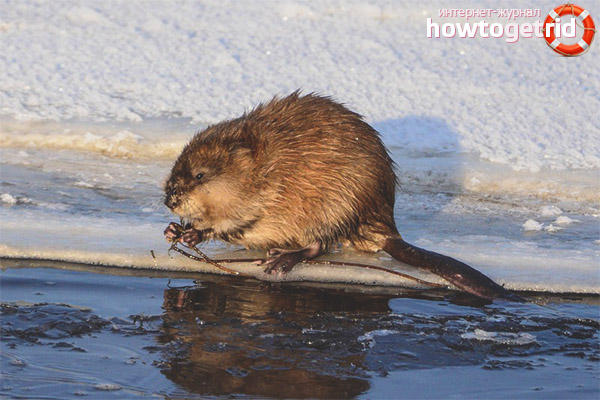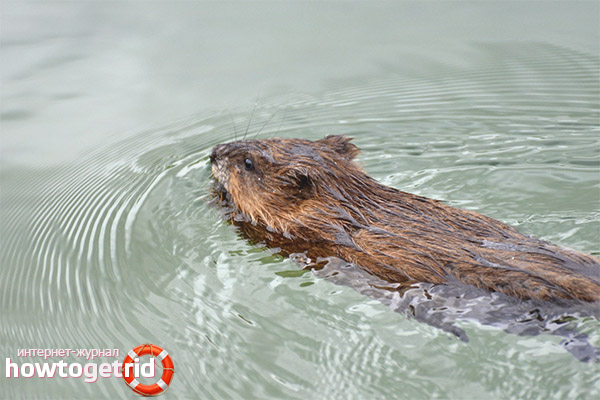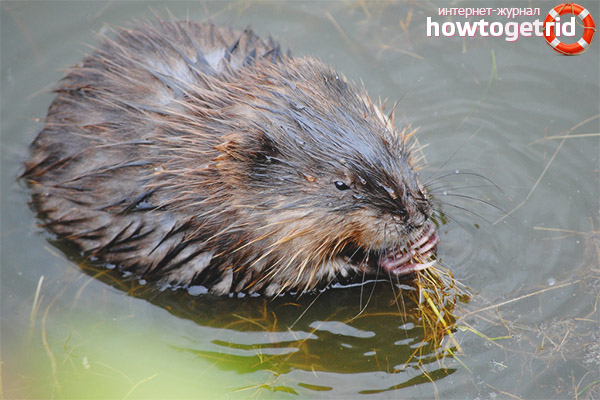The content of the article
Muskrat - a mammal of the order of semi-aquatic rodents, belongs to the subfamily of voles. In its size, the animal reaches up to 60 cm, and about half of the entire length of the body falls on the tail. Visually, this rodent resembles a rat, but it has larger parameters. The average weight of the muskrat is approximately 1-1.5 kg. But it can reach a weight of 1.8 kg.
Representatives of this species are characterized by dense rich fur, found in several shades: from brown to dark brown, less often - black. The fur in the abdomen is gray with a blue tint. Muskrat fur is of high value and is expensive.
There is no fur on the tail; it is covered with scaly plates. The tail has a flat shape, which allows the rodent to be an excellent swimmer. Also, this ability is enhanced by the presence of swimming membranes between the fingers of the hind legs. This natural feature explains the fact that the muskrat spends most of its life in the aquatic environment. The time they are able to stay under water is approximately 17 minutes. When the muskrat is on land, it becomes inherent in slowness, while in the water the animal is agile and dexterous.
This rodent is distinguished by such quality as courage, and even aggressiveness. Able to pounce on a person if he infuriates him and the animal appears to be an enemy. But this is characteristic to a large extent for muskrats living in the wild. Animals bred in captivity are not so aggressive and more peaceful.
The muskrat is bred by humans in order to obtain fur, because the fur of this animal is expensive and appreciated in the market. Meat, on the contrary, is not considered valuable. However, it has gained popularity in some countries. For example, in North America, the meat of this rodent was compared with rabbit. And the fat of this animal has many therapeutic effects.
What environment does the muskrat live in?
The predominantly optimal habitat for the rodent is the pond, because in it the muskrat can spend most of its life. In reservoirs, which in large quantities contain the remains of vegetation and silt, the individual builds a hole with huts, where he lives and reproduces for a long time. Of particular importance for the muskrat is that its place of residence is not subjected to freezing.
Burrows that build muskrats for themselves, as a rule, have a close proximity to each other - at a distance of up to 50 cm. The animals are settled by families in which the number of inhabitants is related to the size of the reservoir they occupy. The average number of such families per 100 acres is from one to six. In excess of permissible indicators and with overpopulation among muskrats cannibalism is possible.
Although the most common type of housing that the muskrat builds for permanent residence is such a house, a rodent can also build nests. This type of shelter is most preferable for the animal in the winter. For its construction, in addition to vegetation, ice is used. First, the muskrat makes a hole, but only after it follows a nest, the diameter of which can be up to 40 cm.Despite the fact that such a dwelling is made of ice, it is always insulated by vegetation from the inside and is in a dry state, retaining heat.
As a rule, the hole is equipped with several exits to the outside, which are located in the roots of a tree growing near the shore. The entrance is located above the water level, which avoids the threat of attack by predators, among which are many enemies of the muskrat. Since the animal does not differ in particularly large size, any animal larger than it becomes dangerous for him. In times of extreme danger, when there is no possibility of shelter in its hole, the muskrat uses claws and teeth for defense.
The site for the construction of the huts is selected taking into account the characteristics of the terrain. The place should have rich vegetation with dense thickets under water. The erected huts are almost identical in size and shape. The construction begins in the fall, the construction process continues throughout the winter. In addition to permanent dwellings, it is typical for the muskrat to build floating nests, which are used as feeding grounds.
For this rodent, a free way of life is inherent, therefore, the conditions in which the muskrat lives at home should be close to those available to the wild beast. Accordingly, enclosures for breeding muskrat must be equipped with a pool of water. The animal simply cannot exist without water, since it provides its vital processes - maintaining hygiene and cleanliness, washing the eye mucosa. Therefore, without water, the muskrat can die.
Replacement of water in the pool for this animal should be done as often as possible, at least 1 time in 3 days. In addition, the size of the pool area should be taken into account. Since the rodent is characterized by physical activity and high mobility, it needs an enclosure of an impressive size.
Muskrat Life - Duration and Reproduction
The life span of a rodent is quite low, which is characteristic of this detachment as a whole. Moreover, the time period of the life of the muskrat varies depending on the conditions of its residence. So, the animal, which was bred and raised in captivity, lives about 10 years, while the wild lives no more than three.
Muskrats go through the process of puberty before the age of six months. The female needs 1 month to bear offspring. And the number of babies in the brood for one pregnancy can be up to 8. At birth, they are completely naked and completely blind, the weight of each of them does not exceed 25 grams. Feeding by their mother lasts about one month. Muskrat cubs come to independence after 2 months. The frequency of offspring in this animal can reach up to three times a year.
With the beginning of the warm period, the male muskrat goes on to “courtship” the female, making a characteristic squealing sound. In this animal, males are actively involved in the process of raising their offspring.
Muskrat birth rates usually fall sharply with the onset of autumn. At this time, it is not possible to meet a female bearing offspring. This explains why the start of the hunting season for animals takes place in the fall. A surge in activity in the processes of reproduction of the muskrat, grown in captivity, also occurs in the spring.
Before the cubs are born, muskrats necessarily begin to build a nest for themselves. In this connection, a few days before the onset of labor, when the male and the female begin the construction process, it is necessary to put the necessary materials in their enclosure: land in small quantities, various branches.
About a week after the female gives birth to babies, all the moments associated with raising offspring are taken over by the male father. Transplantation of a brood from adults should be carried out upon reaching one month of age, not earlier.If you complete the period of feeding the young with the female 3 days earlier, the likelihood of receiving another offspring in the current year increases.
Features of the muskrat
The population of the muskrat population is a very stable, constant indicator. Periodically, a change is possible with a decrease or increase in the population, but this is not associated with the factor of human intervention, but is due to nature.
Although muskrats are rodents that feed mainly on plant foods, they can also eat foods of animal origin, most often frogs, insects. The rodent almost does not eat fish. Such impurities in the diet can be caused by a lack of nutrients. The main components of the diet of wild muskrat are as follows: horsetail, reed, cattail, duckweed, sedge. In conditions of growing animals in captivity, they strive to create a similar diet, but with a slight addition of animal food. As a rule, this is waste from fishing or meat production.
Muskrats can also eat many more other products - fresh herbs, cereals and animal feed. In addition, when breeding at home, the pet needs to be fed with an egg shell, which must first be crushed with brewer's yeast.
The skin and fur of the muskrat: dressing and value
When dressing the skin, it is processed properly. To do this, the skin must first be completely dried, and then degreased. After drying and dressing, you can start dressing.
Large elements of hides are used for sewing large-scale fur products, and small ones, as a rule, are used to create hats. Products made of muskrat fur are pleasant to wear and are able to please almost any fashionista. After all, this fur is also distinguished by its special softness, high ability to warm and the beauty of its appearance.
Video: muskrat (Ondatra zibethicus)













Submit